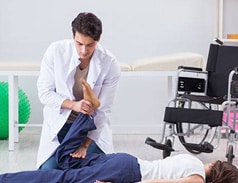Does your knee click catch and lock? Does doing the twist sound most unpleasant for your knee? You may have a meniscus injury.
Keep reading to find out how physio can help!
You may have an acute meniscal injury if you heard or felt a popping sensation in your knee when playing a contact sport.
So what to do if this happens? Should you have surgery? Or can this be treated with physio.
You don’t have to have a sporting injury to do a meniscus tear though. You may also have a meniscal tear if you are older and have had previous knee injuries or osteoarthritis – we call this a degenerative tear. Should this be treated with surgery?
Keep reading to learn what type of meniscus injuries need surgery and which can be treated conservatively.
Surgery VS Conservative Management
In some cases a large meniscal injury may do better with surgery. If you are younger (under 40) and your symptoms are serious enough to have a large impact on your activities function and quality of life you may benefit from surgery. If you aren’t as affected by your symptoms or you are a tad older you may be better off starting with conservative management {rehab equip}. If you don’t get results from conservative management, surgery can be considered later. Worst case, if you do end up having to have surgery – the more “prehabbed” you are, the more likely you will have a better outcome down the track.
So there is no harm in beginning a course of conservative management, either instead of surgery, or while waiting for surgery. If you do decide to have surgery, you will also need rehabilitation afterwards.
Why? Keep reading to find out.
But first – how do we know you have a meniscus injury?
Here’s some signs and symptoms we look out for:
- Swelling or stiffness in the knee
- Clicking, catching or locking of the knee when going from sitting to standing or from a straight to bent knee
- Pain on twisting through the knee
- Pain going up and down stairs
- A feeling of ‘giving way’ when walking
- Pain on the joint line of your knee
If you have any of these signs and symptoms you may have a meniscus injury. There can be other reasons for these symptoms though so it is important to get it assessed to determine what is wrong and the right course of action for you.
Your physiotherapist can assess your knee by taking a thorough history and physical examination. If warranted we will refer you for imaging. If left untreated your knee function can potentially deteriorate and make even everyday activities painful.
What is the meniscus and why is it important?
There are lots of structures that support the knee joint including the bones, ligaments and muscles. Each has their own function including the meniscus. The meniscus is a C shaped cartilage on the inside (medial) and outside (lateral) part of the knee joint. The medial meniscus is the one that gets injured more often. One of its biggest jobs is to act as a shock absorber for your knee.
The meniscus is slippery and smooth tissue which allows the bones of the upper and lower leg to move smoothly against each other by reducing friction thereby making bending and straightening the knee easier. The surface area of the menisci helps to spread the weight of the body to manage load bearing forces through the knee. It can take some time for the meniscus to heal when injured – roughly 3-6 months, sometimes longer.
Why does it take so long to heal?
The menisci do not have a large direct blood supply instead they are nourished primarily by the synovial fluid in your knee joint. This fluid lubricates and helps protect the surfaces of the joint in movement. This means though that it takes longer for the tissue to heal when there isn’t a direct blood supply. Does that mean my knee now has no ability to absorb shock now that it is injured? No! What else acts as a shock absorber for your knee? Continue reading to learn more!
What helps a knee joint cope with injury to the meniscus?
Strength, strength and strength!
Strength of the overall muscles in your legs, glutes & hip flexors. Strength of the muscles closest to your knee, hamstrings & calf muscles and strength of the quads. Why? Your muscles act like shock absorbers too!
The stronger these muscles are the better your knee joint is able to cope with whatever activities you want to give it. It doesn’t mean you need to become an Olympic lifter, but you do need to have enough strength to do the things you enjoy in life, which is different for everyone.
For you this may look like:
Playing sport, running/walking up the golden bay steps, playing with your kids/grandkids, gardening, walking in the park or walking your dog.
SO why would exercises from a physio help?
We can assess your specific muscle strength impairments and give you exercises that are suitable for your knee condition where you are right now in your life. We can then work with you to progress your strengthening and rehab program to get you back to living your life or prehab you for surgery to achieve the best possible outcome. So if you have hurt your knee come and see a physio at Miami or Lakelands physiotherapy for a proper assessment and a planned rehab journey.

